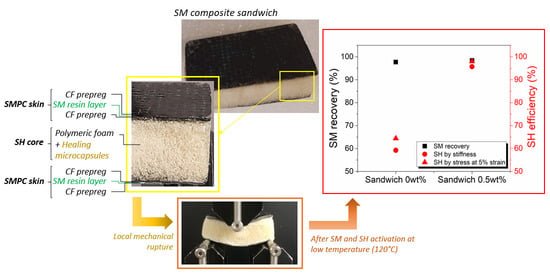Shape Memory Composite Sandwich Structures with Self-Healing Properties
Abstract
:1. Introduction
2. Materials and Methods
2.1. Materials
2.1.1. Self-Healing Capsules Fabrication
2.1.2. Shape Memory Composite Laminates
2.1.3. Polyurethane Foams
2.1.4. SM Sandwich Structures
2.2. Methods of Experimental Evaluation
2.2.1. SH Capsule Characterization by Means of Optical Microscopy
2.2.2. PU Foams Evaluation
2.2.3. SM Sandwich Structures Evaluation
3. Results
3.1. Sample Structures
3.2. Mechanical Properties, Shape Memory Effect and Self-Healing Performance of PU Foams
3.3. Mechanical Properties, Shape Memory Effect and Self-Healing Performance of SM Sandwiches
4. Discussion
5. Conclusions
Author Contributions
Funding
Conflicts of Interest
References
- Du:, H.; Liu, L.; Zhang, F.; Leng, J.; Liu, Y. Triple-shape memory effect in a styrene-based shape memory polymer: Characterization, theory and application. Compos. B Eng. 2019, 173, 106905. [Google Scholar] [CrossRef]
- Santo, L.; Quadrini, F.; Bellisario, D.; Iorio, L. Applications of shape-memory polymers, and their blends and composites. Adv. Struct. Mater. 2020, 115, 311–329. [Google Scholar]
- Qi, X.; Xiu, H.; Wei, Y.; Zhou, Y.; Guo, Y.; Huang, R. Enhanced shape memory property of polylactide/thermoplastic poly (ether) urethane composites via carbon black self-networking induced co-continuous structure. Compos. Sci. Technol. 2017, 139, 8–16. [Google Scholar] [CrossRef]
- Li, W.B.; Liu, Y.J.; Leng, J.S. Shape memory polymer nanocomposite with multi-stimuli response and two-way reversible shape memory behavior. RSC Adv. 2014, 4, 61847–61854. [Google Scholar] [CrossRef]
- Le, X.; Lu, W.; Xiao, H.; Wang, L.; Ma, C.; Zhang, J. Fe(3+)-, pH-, Thermoresponsive Supramolecular Hydrogel with Multishape Memory Effect. ACS Appl. Mater. Interfaces 2017, 9, 9038–9044. [Google Scholar] [CrossRef] [PubMed]
- Madhubhashitha, H.; Jayantha, E.; Mainul, I.; Liang, F.; Jinsong, L. Light activated shape memory polymers and composites: A review. Eur. Polym. J. 2020, 136, 109912. [Google Scholar]
- Wang, K.J.; Strandman, S.; Zhu, X.X. A mini review: Shape memory polymers for biomedical applications. Front. Chem. Sci. Eng. 2017, 11, 143–153. [Google Scholar] [CrossRef]
- Zhao, W.; Zhang, F.; Leng, J.; Liu, Y. Personalized 4D printing of bioinspired tracheal scaffold concept based on magnetic stimulated shape memory composites. Compos. Sci. Technol. 2019, 184, 107866. [Google Scholar] [CrossRef]
- Wu, D.Y.; Meure, S.; Solomon, D. Self-healing polymeric materials: A review of recent developments. Prog. Polym. Sci. 2008, 33, 479–522. [Google Scholar] [CrossRef]
- Paul Christopher, J.E.; Mohamed, T.H.S.; Chithirai, P.S.; Siva, I.; Faizal, M.; Adi Azriff, B.; Syafiqah, N.A.S. Manufacturing challenges in self-healing technology for polymer composites—A review. J. Mater. Res. Technol. 2020, 9, 7370–7379. [Google Scholar]
- Appuhamillage, G.A.; Reagan, J.C.; Khorsandi, S.; Davidson, J.R.; Voit, W.; Smaldone, R.A. 3D printed remendable polylactic acid blends with uniform mechanical strength enabled by a dynamic Diels-Alder reaction. Polym. Chem. 2017, 8, 2087–2092. [Google Scholar] [CrossRef]
- Kuang, X.; Liu, G.M.; Dong, X.; Wang, D.J. Enhancement of mechanical and selfhealing performance in multiwall carbon nanotube/rubber composites via Diels Alder bonding. Macromol. Mater. Eng. 2016, 301, 535–541. [Google Scholar] [CrossRef]
- Kakuta, T.; Takashima, Y.; Nakahata, M.; Otsubo, M.; Yamaguchi, H.; Harada, A. Preorganized hydrogel: Self-healing properties of supramolecular hydrogels formed by polymerization of host-guest-monomers that contain cyclodextrins and hydrophobic guest groups. Adv. Mater. 2013, 25, 2849–2853. [Google Scholar] [CrossRef]
- Wang, Y.; Pham, D.T.; Zhang, Z.; Li, J.; Ji, C.; Liu, Y.; Leng, J. Sustainable self-healing at ultra-low temperatures in structural composites incorporating incurve vessels and heating elements. R. Soc. Open Sci. 2016, 3, 160488. [Google Scholar] [CrossRef] [PubMed] [Green Version]
- Yang, X.T.; Guo, Y.Q.; Luo, X.; Zheng, N.; Ma, T.B.; Tan, J.J.; Li, C.M.; Zhang, Q.Y.; Gu, J.W. Self-healing recoverable epoxy elastomers and their composites with desirable thermal conductivity by incorporating BN fillers via in-situ polymerization. Compos. Sci. Technol. 2018, 164, 59–64. [Google Scholar] [CrossRef]
- Lewis, C.L.; Dell, E.M.J. A review of shape memory polymers bearing reversible binding groups. Polym. Sci. Part B Polym. Phys. 2016, 54, 1340–1364. [Google Scholar] [CrossRef]
- Nand, J.K.; Eva, G.; Umesh, K.V.; Gyanendra, K.S. Self-healing composites: A state-of-the-art review. Compos. Part A 2019, 121, 474–486. [Google Scholar]
- Xu, X.; Fan, P.; Ren, J.; Cheng, Y.; Ren, J.; Zhao, J.; Song, R. Self-healing thermoplastic polyurethane (TPU)/polycaprolactone (PCL) /multi-wall carbon nanotubes (MWCNTs) blend as shape-memory composites. Compos. Sci. Technol. 2018, 168, 255–262. [Google Scholar] [CrossRef]
- Chen, Y.; Zhao, X.; Luo, C.; Shao, Y.; Yang, M.-B.; Yin, B. A facile fabrication of shape memory polymer nanocomposites with fast light-response and self-healing performance. Compos. Part A 2020, 135, 105931. [Google Scholar] [CrossRef]
- Hentschel, J.; Kushner, A.M.; Ziller, J.; Guan, Z.B. Self-healing supramolecular block copolymers. Angew. Chem. Int. Ed. 2012, 51, 10561–10565. [Google Scholar] [CrossRef]
- Yang, Y.; Terentjev, E.M.; Wei, Y.; Ji, Y. Solvent-assisted programming of flat polymer sheets into reconfigurable and self-healing 3D structures. Nat. Commun. 2018, 9, 1906. [Google Scholar] [CrossRef] [PubMed] [Green Version]
- Kuang, X.; Chen, K.J.; Dunn, C.K.; Wu, J.T.; Li, V.C.F.; Qi, H.J. 3D printing of highly stretchable, shape-memory, and self-healing elastomer toward novel 4D printing. ACS Appl. Mater. Interfaces 2018, 10, 7381–7388. [Google Scholar] [CrossRef] [PubMed]
- Du, W.; Jin, Y.; Pan, J.; Fan, W.; Lai, S.; Sun, X.J. Thermal induced shape-memory and self-healing of segmented polyurethane containing diselenide bonds. J. Appl. Polym. Sci. 2018, 135, 46326. [Google Scholar] [CrossRef]
- Du, W.; Jin, Y.; Lai, S.; Shi, L.; Shen, Y.; Yang, H. Multifunctional light-responsive graphene-based polyurethane composites with shape memory, self-healing, and flame retardancy properties. Compos. Part A 2020, 128, 105686. [Google Scholar] [CrossRef]
- Kong, D.; Li, J.; Guo, A.; Zhang, X.; Xiao, X. Self-healing high temperature shape memory polymer. Eur. Polym. J. 2019, 120, 109279. [Google Scholar] [CrossRef]
- Jony, B.; Roy, S.; Mulani, S.B. Fracture resistance of in-situ healed CFRP composite using thermoplastic healants. Mater. Today Commun. 2020, 24, 101067. [Google Scholar] [CrossRef]
- Li, G. Self-Healing Composites Shape Memory Polymer Based Structures; John Wiley & Sons Ltd.: Hoboken, NJ, USA, 2015. [Google Scholar]
- Williams, H.R.; Trask, R.S.; Bond, I.P. Self-healing sandwich panels: Restoration of compressive strength after impact. Compos. Sci. Technol. 2008, 68, 3171–3177. [Google Scholar] [CrossRef]
- Li, G.; Xu, T. Thermomechanical characterization of shape memory polymer based self-healing syntactic foam sealant for expansion joint. ASCE J. Transp. Eng. 2011, 137, 805–814. [Google Scholar] [CrossRef]
- Li, G.; King, A.; Xu, T.; Huang, X. Behavior of thermoset shape memory polymer based syntactic foam sealant trained by hybrid two-stage programming. ASCE J. Mater. Civil Eng. 2013, 25, 393–402. [Google Scholar] [CrossRef]
- Behl, M.; Bellin, I.; Kelch, S.; Wagermaier, W.; Lendlein, A. One-step process for creating triple-shape capability of AB polymer networks. Adv. Funct. Mater. 2009, 19, 102–108. [Google Scholar] [CrossRef]
- Santo, L.; Quadrini, F. Shape memory composite sandwich with self-healing properties for marine applications. In Proceedings of the ICCM International Conferences on Composite Materials, ICCM 2015, Copenhagen, Denmark, 19–24 July 2015; p. 138792. [Google Scholar]
- Brown, E.N.; Kessler, M.R.; Sottos, N.R.; White, S.R. In-situ poly(urea-formaldehyde) microencapsulation of dicyclopentadiene. J. Microencapsul. 2003, 20, 719–730. [Google Scholar] [CrossRef] [PubMed] [Green Version]
- Tedde, G.M.; Santo, L.; Bellisario, D.; Iorio, L.; Quadrini, F. Frozen stresses in shape memory polymer composites. Mater. Plast. 2018, 55, 494–497. [Google Scholar] [CrossRef]
- Santo, L.; Bellisario, D.; Iorio, L.; Quadrini, F. Shape memory composite structures for self-deployable solar sails. Astrodynamics 2019, 3, 247–255. [Google Scholar] [CrossRef]
- Zhang, X.X.; Tao, X.M.; Yick, K.L. Structure and thermal stability of microencapsulated phase-change materials. Colloid Polym. Sci. 2004, 282, 330–336. [Google Scholar] [CrossRef]
- Quadrini, F.; Bellisario, D.; Iorio, L.; Santo, L. Shape memory polymer composites by molding aeronautical prepregs with shape memory polymer interlayers. Mater. Res. Express 2019, 6, 115711. [Google Scholar] [CrossRef]
- Quadrini, F.; Iorio, L.; Bellisario, D.; Santo, L. Shape memory polymer composite unit with embedded heater. Smart Mater. Struct. 2021, 30, 075009. [Google Scholar] [CrossRef]
- Santo, L.; Bellisario, D.; Quadrini, F. Shape memory behavior of PET foams. Polymers 2018, 10, 115. [Google Scholar] [CrossRef] [Green Version]
- Singhal, P.; Rodriguez, J.N.V.; Small, W., IV; Eagleston, S.; van de Water, J.; Maitland, D.J.; Wilson, T.S. Ultra low density and highly crosslinked biocompatible shape memory polyurethane foams. J. Polym. Sci. Part B Polym. Phys. 2012, 50, 724–737. [Google Scholar] [CrossRef] [Green Version]
- Hearon, K.; Singhal, P.; Horn, J.; Small, W., IV; Olsovsky, C.; Maitland, K.C.; Wilson, T.S.; Maitland, D.J. Porous shape-memory polymers. Polym. Rev. 2013, 53, 41–75. [Google Scholar] [CrossRef] [Green Version]
- Hasan, S.M.; Nash, L.D.; Maitland, D.J. Porous Shape Memory Polymers: Design and Applications. J. Polym. Sci. Part B Polym. Phys. 2016, 54, 1300–1318. [Google Scholar] [CrossRef] [Green Version]
- Gibson, L. Modelling the mechanical behavior of cellular materials. J. Mater. Sci. Eng. 1989, A110, 1–36. [Google Scholar] [CrossRef]
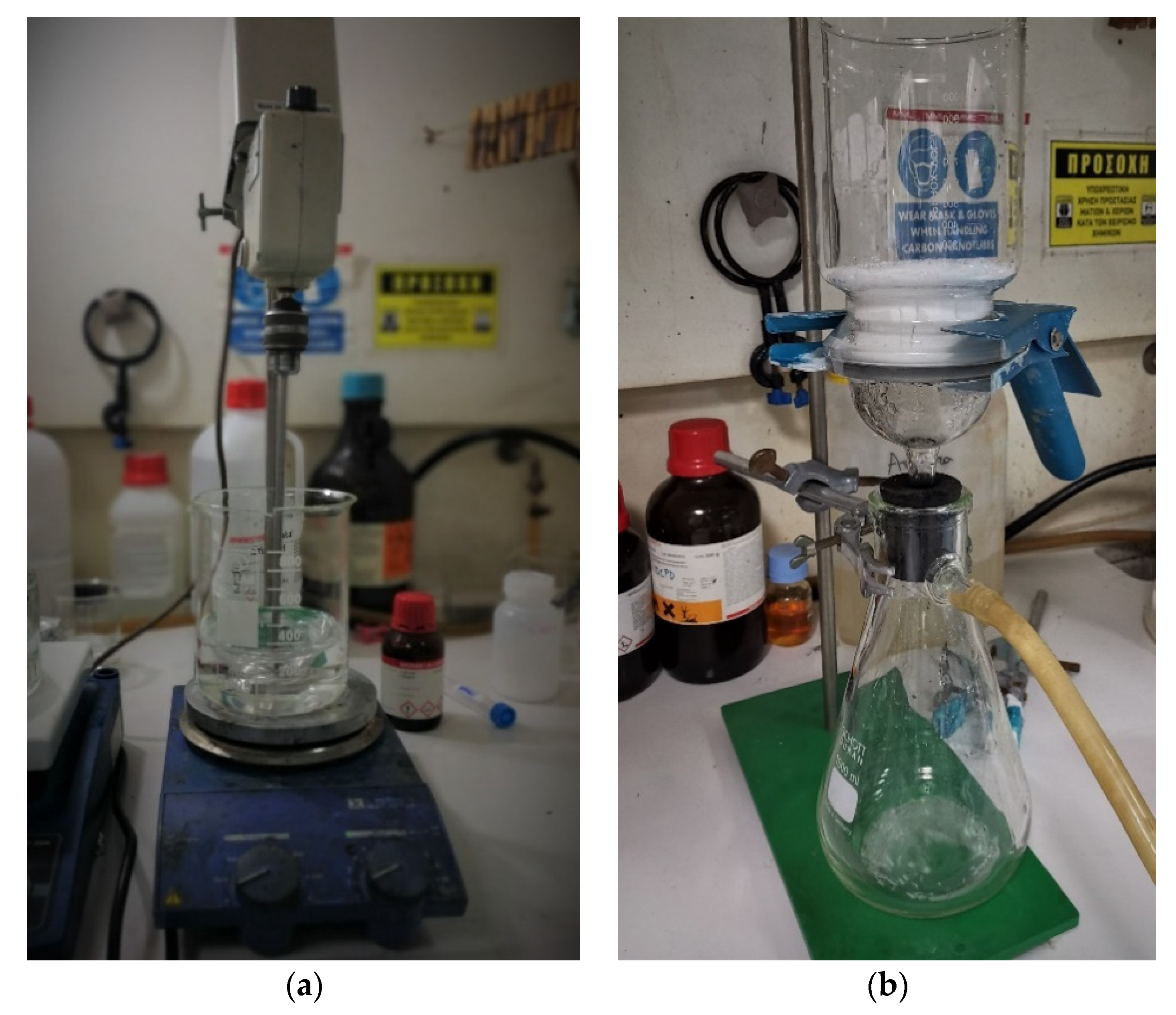
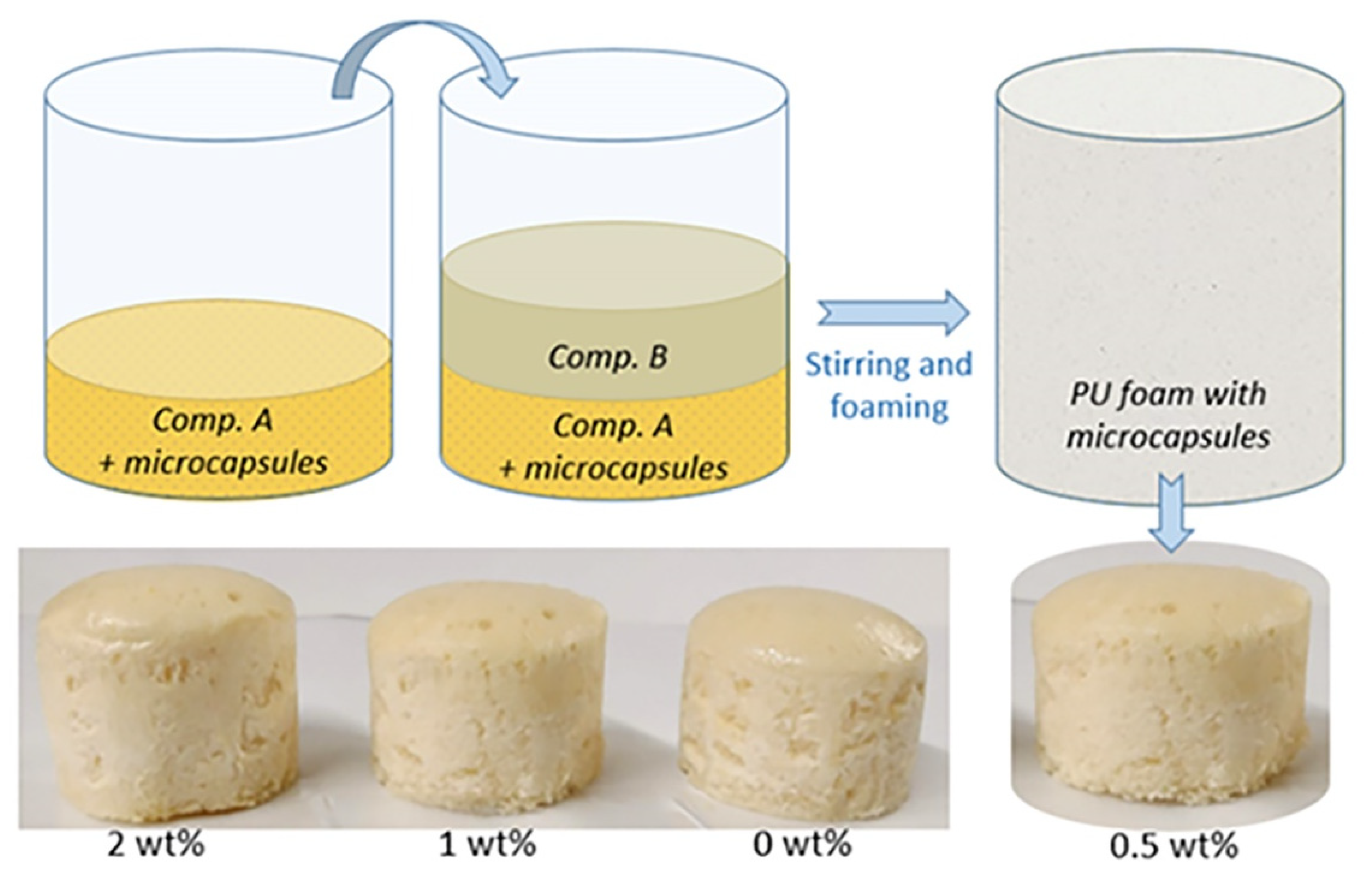

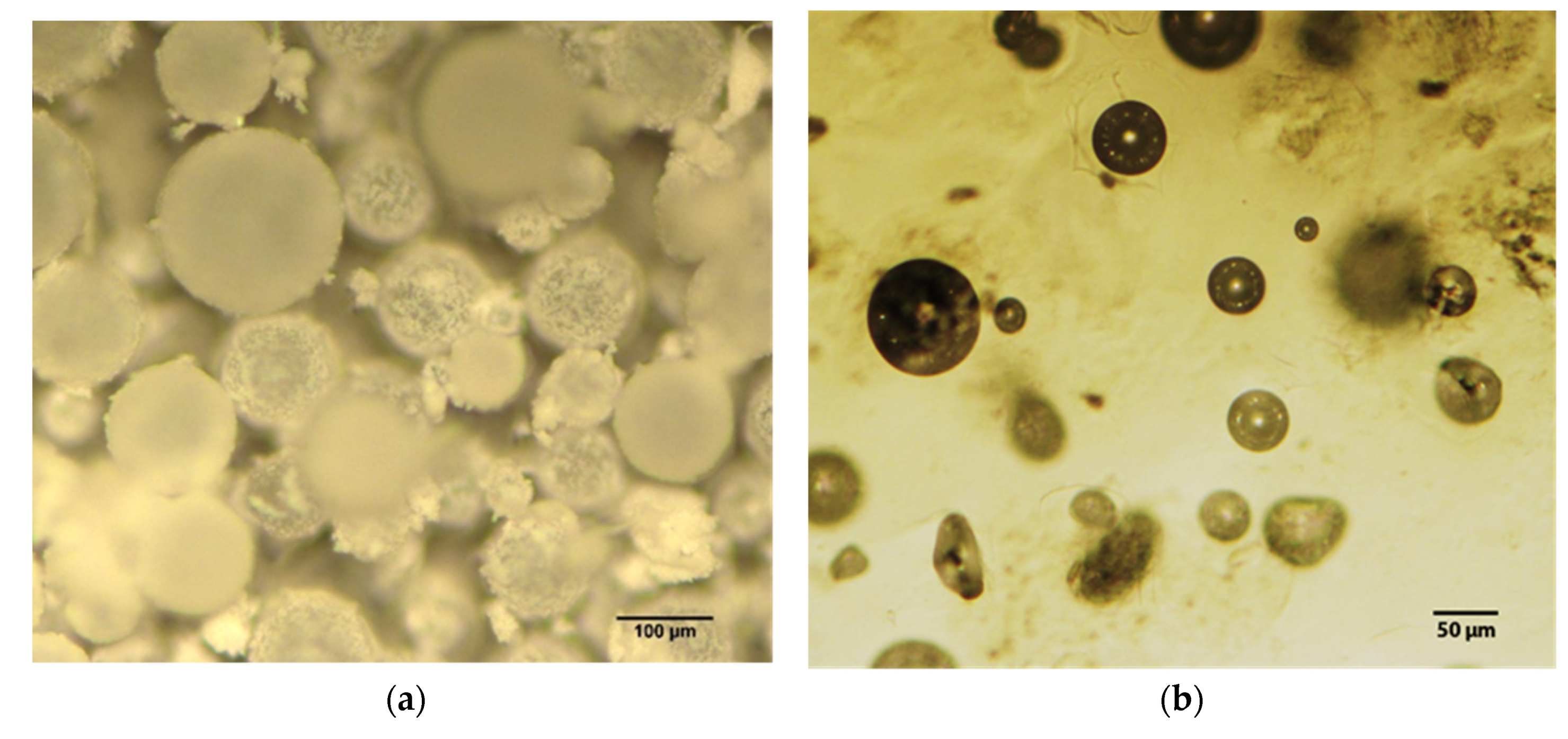
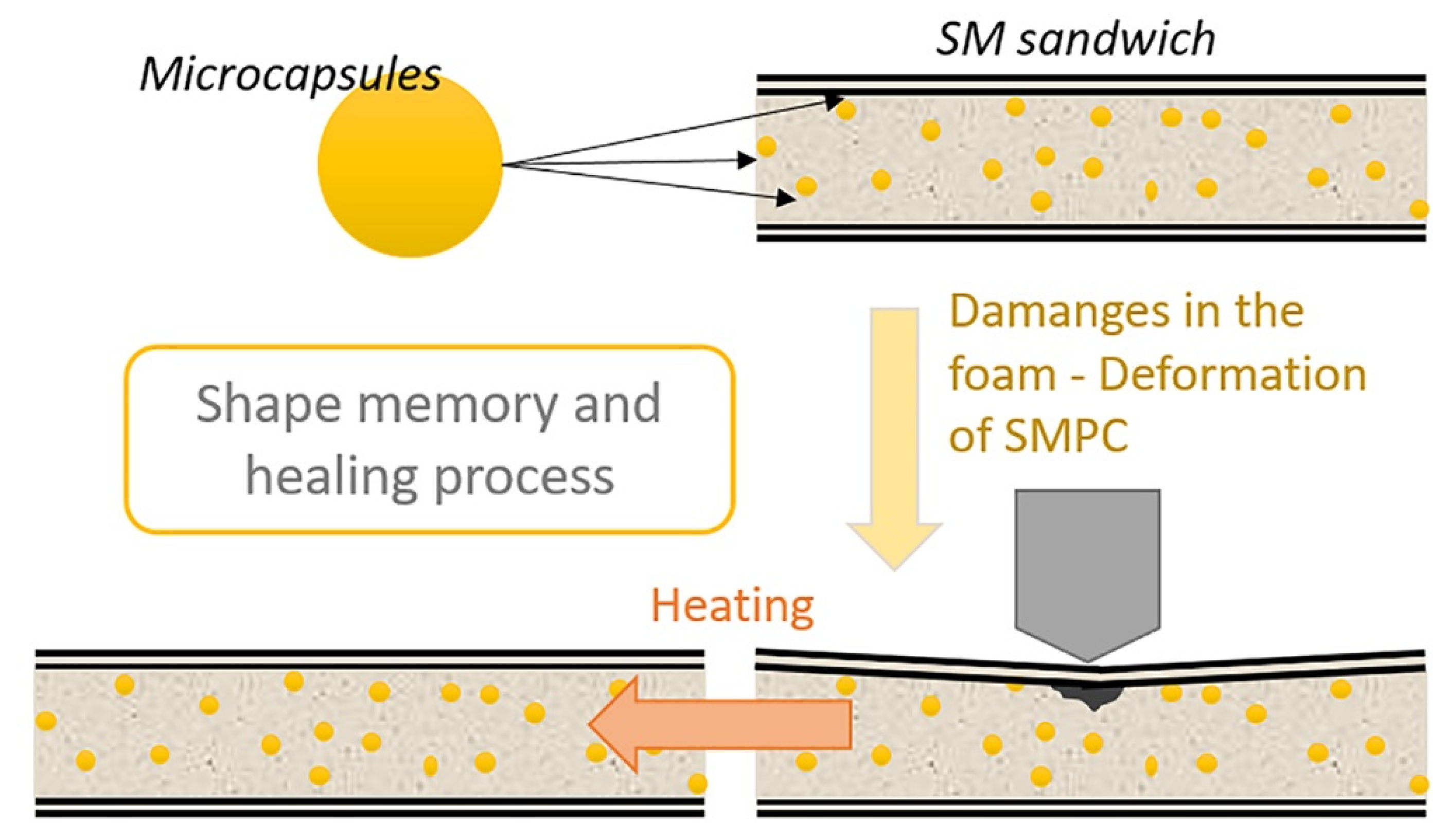
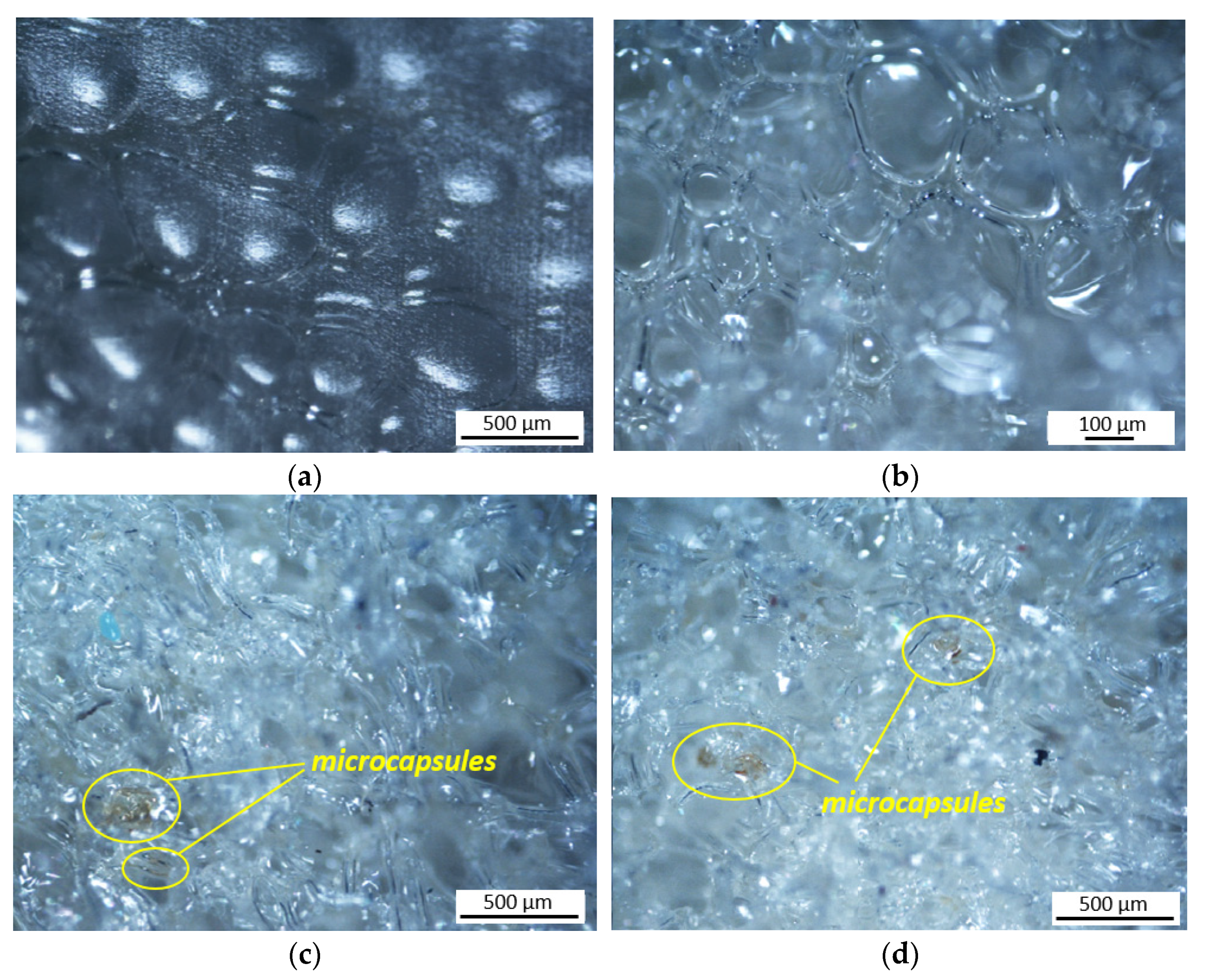

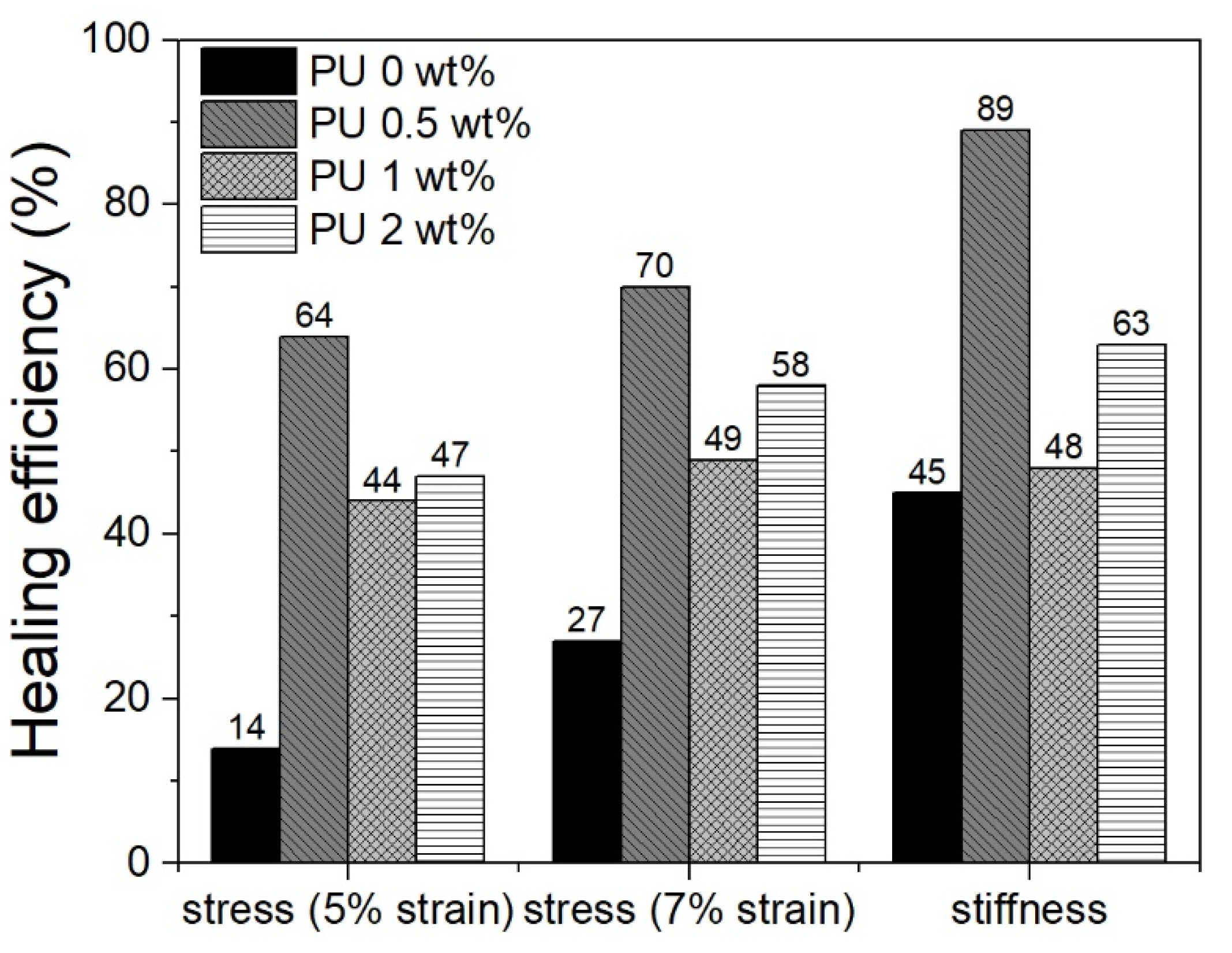
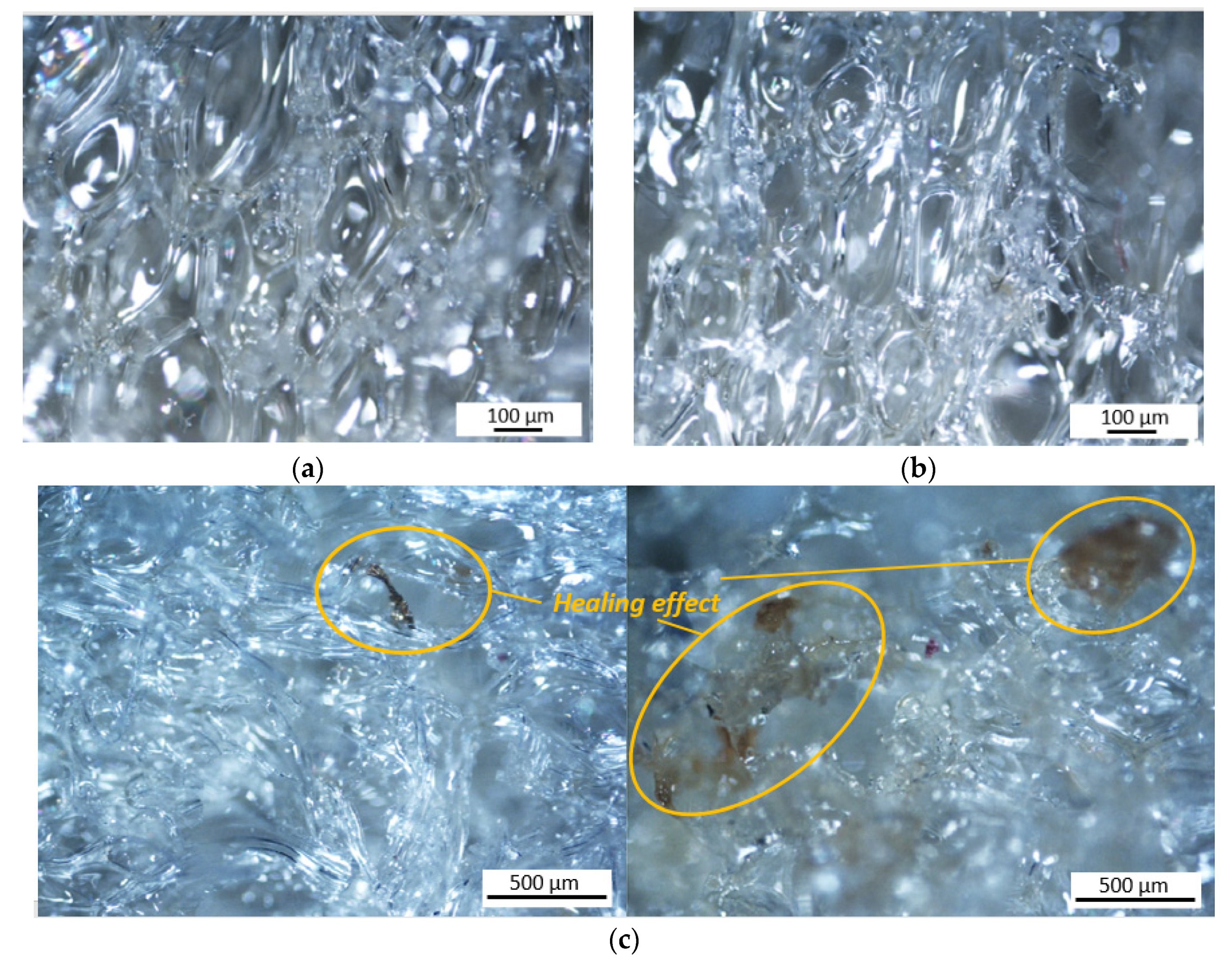
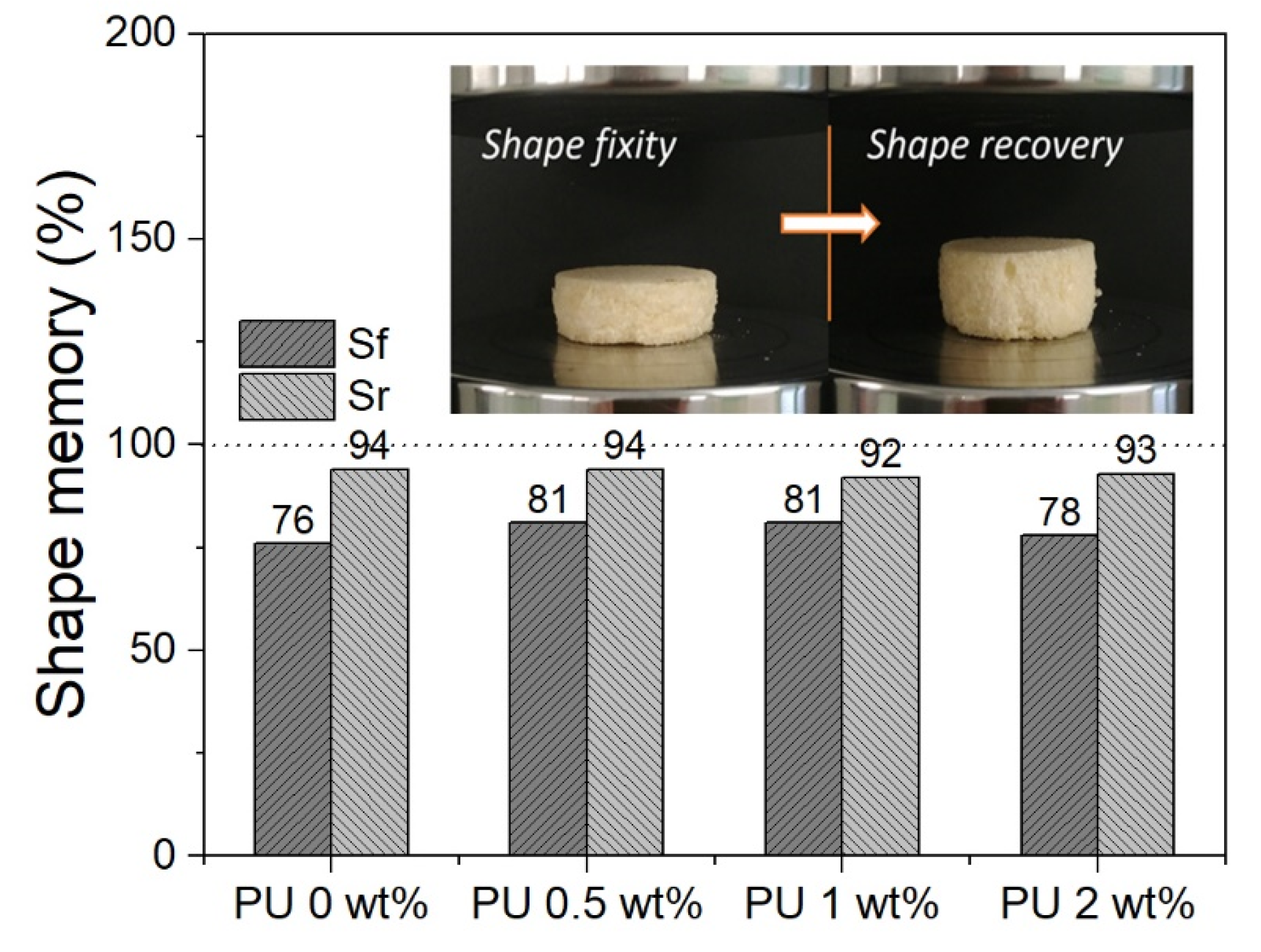
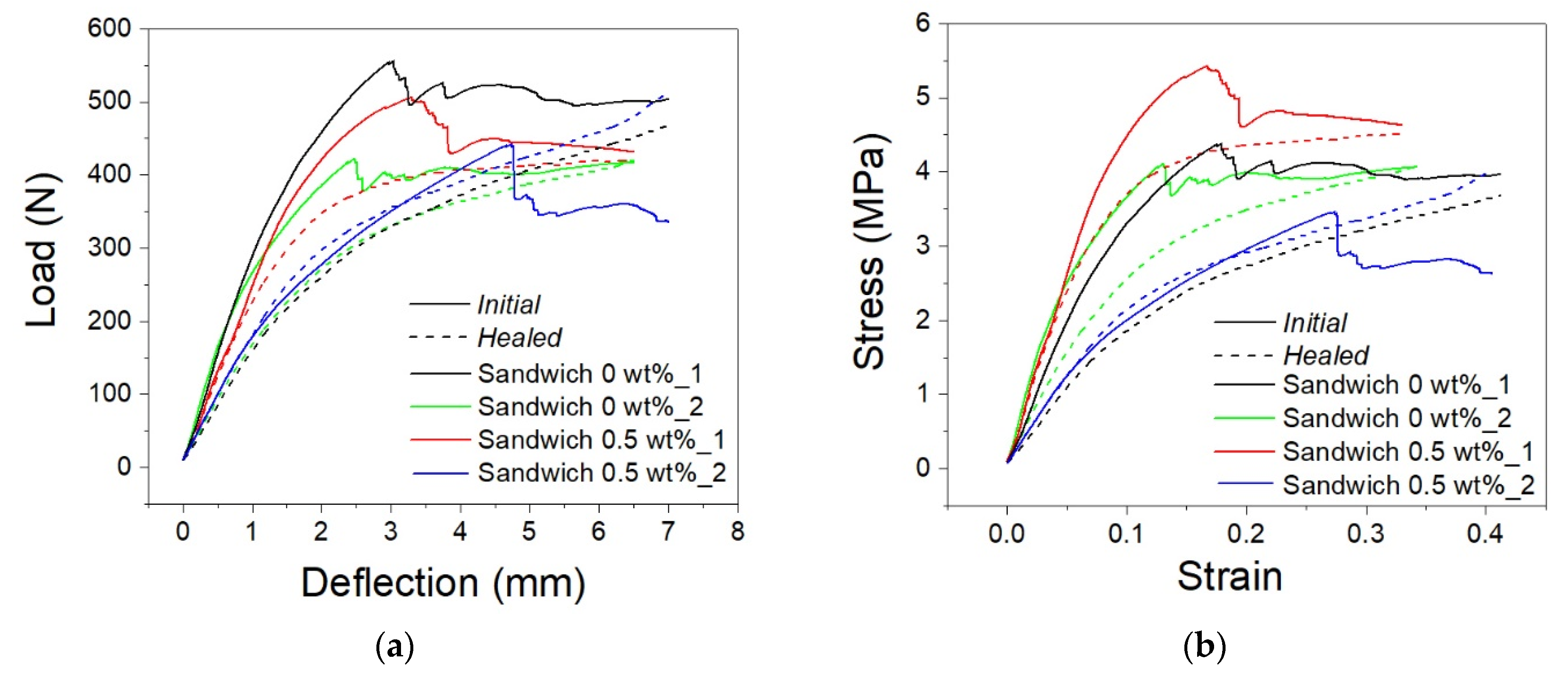

| Property | Component A | Component B |
|---|---|---|
| Viscosity at 25 °C (mPa.s) | 1030 ± 100 | 200 ± 30 |
| Density at 25 °C (kg/L) | 1.07 ± 0.02 | 1.23 ± 0.02 |
| Sample | Diameter (mm) | Height (mm) | Weight (g) | Density (g/cm3) |
|---|---|---|---|---|
| PU foam 0 wt% | 36.53 ± 0.05 | 27.71 ± 0.15 | 2.17 | 0.12 |
| PU foam 0.5 wt% | 36.61 ± 0.14 | 27.92 ± 0.12 | 2.04 | 0.11 |
| PU foam 1 wt% | 36.037 ± 0.319 | 28.86 ± 0.084 | 2.68 | 0.12 |
| PU foam 2 wt% | 35.953 ± 0.200 | 30.38 ± 0.12 | 2.44 | 0.12 |
Publisher’s Note: MDPI stays neutral with regard to jurisdictional claims in published maps and institutional affiliations. |
© 2021 by the authors. Licensee MDPI, Basel, Switzerland. This article is an open access article distributed under the terms and conditions of the Creative Commons Attribution (CC BY) license (https://creativecommons.org/licenses/by/4.0/).
Share and Cite
Quadrini, F.; Bellisario, D.; Iorio, L.; Santo, L.; Pappas, P.; Koutroumanis, N.; Anagnostopoulos, G.; Galiotis, C. Shape Memory Composite Sandwich Structures with Self-Healing Properties. Polymers 2021, 13, 3056. https://doi.org/10.3390/polym13183056
Quadrini F, Bellisario D, Iorio L, Santo L, Pappas P, Koutroumanis N, Anagnostopoulos G, Galiotis C. Shape Memory Composite Sandwich Structures with Self-Healing Properties. Polymers. 2021; 13(18):3056. https://doi.org/10.3390/polym13183056
Chicago/Turabian StyleQuadrini, Fabrizio, Denise Bellisario, Leandro Iorio, Loredana Santo, Panagiotis Pappas, Nikolaos Koutroumanis, George Anagnostopoulos, and Costas Galiotis. 2021. "Shape Memory Composite Sandwich Structures with Self-Healing Properties" Polymers 13, no. 18: 3056. https://doi.org/10.3390/polym13183056
APA StyleQuadrini, F., Bellisario, D., Iorio, L., Santo, L., Pappas, P., Koutroumanis, N., Anagnostopoulos, G., & Galiotis, C. (2021). Shape Memory Composite Sandwich Structures with Self-Healing Properties. Polymers, 13(18), 3056. https://doi.org/10.3390/polym13183056








